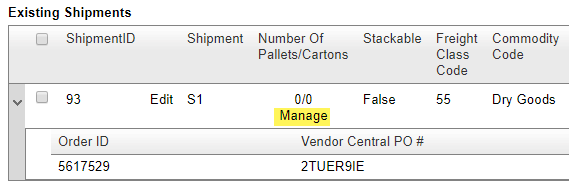In order to request routing for Vendor Central shipments, the packages must be configured with the pallet count (if any), carton count, carton contents, weights and dimensions.
There are several ways to set up the package configuration:
- Manually
- Auto Generate using case qty
- In bulk with a File Upload
To begin, click the Manage link on the shipment in the grid:

Manual configuration
- Small Parcel Shipments:
- Click Add New Carton. To create multiple cartons at once, enter the number of cartons to add in the Cartons textbox and check Copy Dimensions if you want all the new cartons to have the same dimensions.
- Click Manage Items on the carton to define the box contents. The carton number will appear the top of the page. Set the qty for each item in this box, as well as the expiration date, if applicable, and click Save. You must do this for each carton, until all items in the shipment have been fully assigned. You can switch between cartons on the current shipment from within the Manage Items page by using the Select Carton dropdown menu.
Vendor Central does not allow different units of the same SKU in the same carton to have different expiration dates:
a. If units of the same SKU have different expiration dates, they must be shipped in different cartons.
b. If units of different SKUs have different expiration dates, they can be shipped in the same carton. - Return to the list of cartons and set the weights and dimensions of each one. If the items in the carton have a shipping weight set in Sellercloud, the carton weight will be calculated automatically, though you would still want to double-check that it is correct. Be sure to click Update Carton(s) after setting all the weights and dimensions.
- LTL Shipments:
- Click Add New Pallets. To create multiple pallets at once, enter the number of pallets to add in the Pallets textbox and check Copy Dimensions if you want all the new pallets to have the same dimensions.
- Follow the same steps as for small parcel shipments to add cartons to each pallet and then to set up box content for each pallet.
- After assigning all items to cartons, go back to each carton and pallet and check to make sure the weights are accurate.
- For LTL shipments with loose cartons but no pallets, you can choose Add Cartons Without Pallets instead of Add New Pallets. You will be directed to the Manage Cartons page without having to add any pallets. Each LTL shipment can have either pallets or loose cartons, but not both.
Auto generate pallet and carton configuration using case qty
If your items are set up as cases in Sellercloud, and you will be shipping entire cases to Vendor Central, you can have the cartons (and pallets, for LTL shipments) configured automatically with just one click.
First, make sure all the items in the shipment have the necessary information set:
- On the product details page, open the Toolbox and click Purchasing.
- Set the following fields: Qty Per Pallet, Qty Per Case, Case Dimensions (L x W x H)
Note: Qty Per Pallet is the number of UNITS that can be shipped in one pallet (not the number of cases on each pallet). - Click Save.
Back on the shipment:
- For LTL shipments, click Auto Generate Pallets and Cartons on the top of the pallets grid.
- For small parcel shipments, click Auto Generate on the top of the cartons grid.
The pallets and cartons will be generated based on the information you set in the Qty Per Pallet and Qty Per Case fields.
Once the configuration is generated automatically, you can still manually add or remove pallets or cartons as needed. If additional items are added to the shipment, or the pallet/case qty changes, you can just regenerate the configuration. Keep in mind though, that this will delete the entire existing configuration, even pallets or cartons that were added/adjusted manually.
The carton weight will be set based on the sum of the weight of the units inside of it, rather than the case weight on the product’s Purchasing page. The pallet weight will be the sum of the carton weights.
Bulk upload configuration
On the right side of the pallet grid for LTL shipments, or the carton grid for small parcel shipments, there is a Bulk Import box.
You can download a sample file (or create your own), add the pallet and/or carton configuration for each item in the shipment, and then import it.
- The pallet numbers and box numbers must be numerical.
- If weights are not supplied in the file, the shipping weights set in Sellercloud will be used.
- If there are multiple lines for a single carton, the weights and dimensions from the last line will be used.